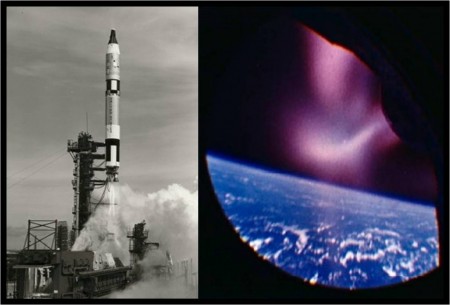Forty-eight years ago this month, NASA successfully completed the unmanned Gemini-Titan 2 (GT-2) space mission. The suborbital spaceflight served as a final test preparatory to the first manned Gemini mission (GT-3) flown several months later.
The Gemini Program was America’s second manned space project. Gemini pioneered key technologies required to land men on the Moon including space navigation, rendezvous, docking, orbital maneuvering, long-duration spaceflight and extra-vehicular activity (EVA). Without Gemini, the United States would not have achieved the goal of landing men on the Moon before the end of the 1960’s.
The two-man Gemini spacecraft weighed 8,500 pounds at lift-off and measured 18.6 feet in length. Gemini consisted of a reentry module (RM), an adapter module (AM) and an equipment module (EM).
The crew occupied the RM which also contained ships’ navigation, communication, telemetry, electrical and reentry reaction control systems. The AM contained maneuver thrusters and the deboost rocket system. The EM included the spacecraft orbital attitude control thrusters and the fuel cell system. Both the AM and EM were used in orbit only and discarded prior to entry.
A two-stage Titan II launch vehicle served as the chariot that Gemini rode into space. Designed for the Intercontinental Ballistic Missile (ICBM) role, the native reliability of the Titan II had to be substantially improved for the vehicle to safely carry men into space. The history of spaceflight records that the man-rated Titan II truly fulfilled the measure of its creation by successfully launching ten (10) Gemini crews into earth orbit.
Gemini-Titan (GT-2) was the second and last unmanned flight test of the Gemini spacecraft. Since the primary goal was to flight-prove the craft’s heat shield performance during reentry, the mission was suborbital in nature. GT-2 lifted-off from Cape Canaveral’s LC-19 at 14:22:14 UTC on Tuesday, 19 January 1965. The vehicle’s arcing ballistic trajectory took it over the Atlantic Ocean on a flight that lasted only 18 minutes and 16 seconds. Maximum altitude and impact range were 92.4 nm and 1,847.5 nm, respectively.
Gemini 2’s ablative heat shield functioned as designed and came through the fiery reentry in excellent condition. Most of the spacecraft’s other flight systems performed satisfactorily during the vehicle’s brief sojourn into the heavens. Exceptions here included the fuel cell system which failed prior to lift-off and cooling system temperatures which exceeded design requirements.
Gemini 2’s splashdown point was located approximately 45 nm from the USS Lake Champlain. About 90 minutes after splashdown, Gemini 2 was hauled aboard the recovery ship. The spacecraft came through the flight in such good shape that it actually flew a second suborbital reentry in November of 1966. Along with the OPS 0855 boilerplate spacecraft, the Gemini 2 reentry module was flown aboard a Titan IIIC launch vehicle in support of the USAF Manned Orbiting Laboratory (MOL) Program.
The successful completion of GT-2 (along with the previous GT-1 orbital mission) provided NASA with the confidence needed to proceed with manned Gemini missions. The first of ten (10) such missions, GT-3, was successfully flown in March of 1965. A mere 20 months later (December 1966), the Gemini Program was brought to a successful conclusion with the splashdown of Gemini 12.
The Gemini Program was remarkable for its many significant and historic spaceflight achievements that paved the way to the moon. The brief mission of Gemini-Titan 2 was a small, but important part of that larger story. Today, aerospace aficionados can view the twice-flown Gemini 2 reentry module at the Air Force Space and Missile Museum, Cape Canaveral, Florida.


